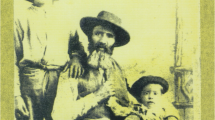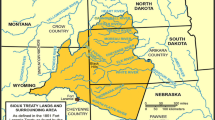Abstract
The Robinson House site is situated within the Manassas National Battlefield Park in northern Virginia. The original Robinson House was constructed in the 1840s and was occupied until 1936 by the same free African-American family. The National Park Service recognizes and interprets the Robinson House since it was part of the Civil War battlefield landscape during the First and Second Battles of Manassas. The original house went through a series of structural additions and alterations in the late 1800s and early 1900s. The house stood until 1993 when arsonists burned it, causing 60% damage to the structure. Today, the east chimney and the stone foundations remain. Amidst the many Civil War monuments at the battlefield park the interpretation of a century of occupation by the Robinson family through the remaining foundations adds meaning and depth to the area's local history. The Robinson House remains symbolize an African-American family's way of life as well as their struggle to survive during Reconstruction and the Jim Crow era. The foundations and site are a steadfast symbol of African-American cultural persistence that has prevailed for over 100 years on a battlefield landscape.
Similar content being viewed by others
REFERENCES CITED
Armstrong, D. V. (1990). The Old Village and the Great Hall: An Archaeological and Historical Examination of Drax Hall Plantation, St. Anns Bay, Jamaica, University of Illinois Press, Urbana.
Boles, J. B. (1983). Black Southerners, 1619–1869, University Press of Kentucky, Lexington.
Brown, K. L., and Cooper, D. C. (1990). Structural continuity in an African-American slave and tenant community. In Orser, C. E., Jr. (ed.), Historical Archaeology on Southern Plantations and Farms, Historical Archaeology 24(4): 7–19.
Burgess, J. (1994). Transcription of the “Robinson Papers.” On file, Manassas National Battlefield Park, Manassas, VA.
Centre View [Centreville, Virginia] (1987). The Robinson-Naylor-Harris reunion—A family celebrates. Aug. 29: 1.
Epperson, T. W. (1991). Race and the disciplines of the plantation. In Orser, C. E., Jr. (ed.), Historical Archaeology on Southern Plantations and Farms, Historical Archaeology 24(4): 29–36.
Ewing, E. W. R. (1921). The Manassas Battlefield Confederate Park Prospectus, rev. ed., Virginia Collection, Prince William County Public Library Manassas, VA.
Ferguson, L. (1992). Uncommon Ground: Archaeology and Early African America 1650–1800. Smithsonian Institution Press, Washington, DC.
Foner, E. (1988). Reconstruction: America's Unfinished Revolution, 1863–1877, Harper and Row, New York.
Friedman, C. D. (1991). Wilmer McLean: The Centreville years. 1991–1992 Yearbook The Historical Society of Fairfax County, Virginia, Vol. 23.
Galke, L. J. (ed.) (1992). Cultural Resource Survey and Inventory of a War-Torn Landscape: The Stuart's Hill Tract, Manassas National Battlefield Park, Virginia, Occasional Report 7, National Park Service, National Capital Region, Washington, DC.
Hernigle, J. L. (1991). Manassas National Battlefield Park Wayside Exhibit Installation Archeological Investigation and Clearance. National Park Service/University of Maryland Cooperative Program. On file, Manassas National Battlefield Park, Manassas, VA.
Holland, C. C. (1990). Tenant farms of the past, present, and future: An ethnoarchaeological view. In Orser, C. E., Jr. (ed.), Historical Archaeology on Southern Plantations and Farms, Historical Archaeology 24(4): 60–69.
Irish-American [New York City] (1863). Corcoran's Irish Legion. Aug. 1.
Johnson, E. H., Conner, E. R., III, and Ferguson, M. H. (1982). History in a Horseshoe Curve, Princeton University Press, Princeton, NJ.
Joseph, M. (1995). Cultural Landscape Inventory: Northeast Quadrant, Manassas National Battlefield Park, Denver Service Center, Manassas, VA.
Kelso, W. M. (1986). Mulberry Row: Slave life at Thomas Jefferson's Monticello. Archaeology 39(5): 28–35.
Kelso, W. M., Patten, M. D., Strutt, M., Bodeman, D., and Johnson, D. (1991). Archaeological excavations at Poplar Forest, Bedford County, Virginia, 1989–1991. On file, Thomas Jefferson's Poplar Forest, Forest, VA.
Klingelhofer, E. (1987). Aspects of early Afro-American material culture: Artifacts from the slave quarters at Garrison Plantation, Maryland. Historical Archaeology 21(2): 112–119.
Little, B. J. (1995). National Capital Area Archeological Overview and Survey Plan. Occasional Report 13, National Park Service, National Capital Area, Washington, DC.
Lowenthal, D. (1985). The Past Is a Foreign Country, Cambridge University Press, Cambridge, England.
Lyon, J. S. (1882). War Sketches: From Cedar Mountain to Bull Run. Buffalo, NY.
McGarry, T. E. (1982). An archeological survey of selected portions of Manassas National Battlefield Park. On file, Manassas National Battlefield Park, Manassas, VA.
Morgan, P. (ed.) (1986). “Don't Grieve After Me”: The Black Experience in Virginia, 1619–1986. Hampton University, Hampton, VA.
Nieman, D. G. (1994). African American Life, 1861–1900: Black Southerners and the Law, 1865–1900, Garland, New York.
Orser, C. E., Jr. (1988). The Material Basis of the Postbellum Tenant Plantation: Historical Archaeology in the South Carolina Piedmont, University of Georgia Press, Athens.
Parker, K. A., and Hernigle, J. L. (1990). Portici: Portrait of a Middling Plantation in Piedmont Virginia, Occasional Report 3, National Park Service, National Capital Region, Washington, DC.
Parsons, M. T. (1996). A social history of the Robinson family and overview of the Robinson House Site: Nearly one hundred years of occupation by a free African-American family in Prince William County, Virginia. Paper presented at the Middle Atlantic Archaeological Conference.
Parsons, M. T. (1997). Archaeological Investigations of the Robinson House, Site 44PW288: A Free African-American Farmstead Occupied from the 1840s to the 1930s, Occasional Report 14, National Park Service, National Capital Area, Washington, DC (in press).
Patten, D. (1992). Mankala and Minkisi: Possible evidence of African American folk beliefs and practices. African American Archaeology 6: 5–7.
Patterson, J. (1989). From battle ground to pleasure ground: Gettysburg as a historic site. In Leon, W., and Rozenzweig, R. (eds.), History Museums in the United States: A Critical Assessment, University of Illinois Press, Urbana, pp. 128–157.
Prince William County, Virginia, Courthouse Deed Books (PWCVC DB) (1840). Prince William County Courthouse, Manassas, VA, Vol. 16, p. 223.
Prince William County, Virginia, Courthouse Deed Books (PWCVC DB) (1848). Prince William County Courthouse, Manassas, VA, Vol. 20, p. 107.
Prince William County Virginia, Courthouse Land Tax Records (1842). Prince William Regional Library, Manassas, VA.
Rainey, R. M. (1983). The memory of war: Reflections on battlefield preservation. In Austin, R. L., Kane, T., Melnick, R. Z., and Turner, S. (eds.), The Yearbook of Landscape Architecture, Van Nostrand Reinhold, New York, pp. 69–89.
Robinson, L. M. (1993). Information sheet on James Robinson. On file, Manassas National Battlefield Park, Manassas, VA.
Ryder, R. L. (1997). Fluid ethnicity: Archaeological examinations of diversity in Virginia from 1800–1900. In Reinhart, T. R., and Sprinkle, J. H. (eds.), The Archaeology of 19th-century Virginia, Special Publication of the Archaeological Society of Virginia (in press).
Sandri, K. (1994). Architectural Fabric Investigation and Documentation of the Robinson House, Manassas National Battlefield Park, National Capital Region, Williamsport Preservation Training Center, PA.
Sweig, D. (ed.) (1977). Registration of Free Negroes Commencing September Court 1822, Book No. 2, Virginia Office of Comprehensive Planning, Manassas, VA.
Turner, R. R. (1993a). An annotated census for Prince William County, Virginia 1850, Manassas, VA.
Turner, R. R. (1993b). Prince William County, Virginia death records 1853–1896, Manassas, VA.
United States War Department (1880). War of the Rebellion: A Compilation of the Official Records of the Union and Confederate Armies, Series I, Vol. 2, Washington, DC.
United States War Department (1885). War of the Rebellion: A Compilation of the Official Records of the Union and Confederate Armies, Series I, Vol. 12, Washington, DC.
Upton, D. (1988). White and black landscapes in eighteenth-century Virginia. In St. George, R. B. (ed.), Material Life in America, 1600–1800, Northeastern University Press, Boston, pp. 357–369.
Vlach, J. M. (1993). Back of the Big House: The Architecture of Plantation Slavery, University of North Carolina Press, Chapel Hill.
War Claim (1872). James Robinson Versus the United States. On file, Manassas National Battlefield Park, Manassas, VA.
Westmacott, R. (1992). African-American Gardens and Yards in the Rural South, University of Tennessee Press, Knoxville.
Williams, V. J., Jr. (1989). From a Caste to a Minority: Changing Attitudes of American Sociologists Toward Afro-Americans, 1896–1945, Greenwood, Westport, CT.
Wilshin, F. F. (1948). Interview with McKinley Robinson, February 21, 27, and March 12, 1948. On file, Manassas National Battlefield Park, Manassas, VA.
Zenzen, J. M. (1995). Battling for Manassas: The Fifty-Year Preservation Struggle at Manassas National Battlefield Park, History Associates, Rockville, MD.
Author information
Authors and Affiliations
Rights and permissions
About this article
Cite this article
Martin, E., Parsons, M. & Shackel, P. Commemorating a Rural African-American Family at a National Battlefield Park. International Journal of Historical Archaeology 1, 157–177 (1997). https://doi.org/10.1023/A:1027359923226
Issue Date:
DOI: https://doi.org/10.1023/A:1027359923226




